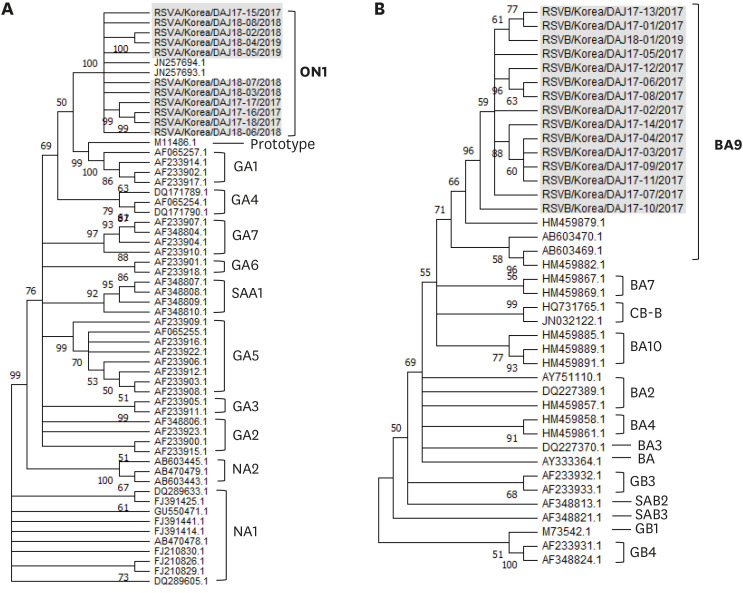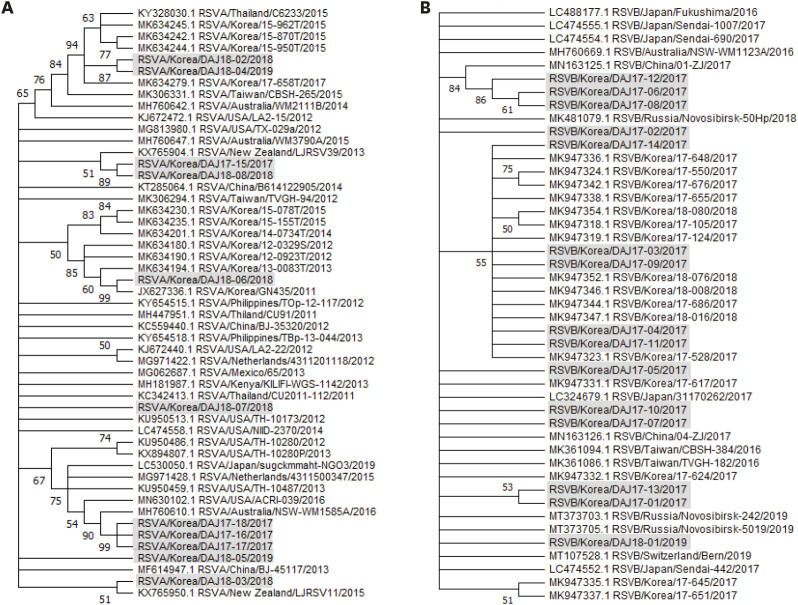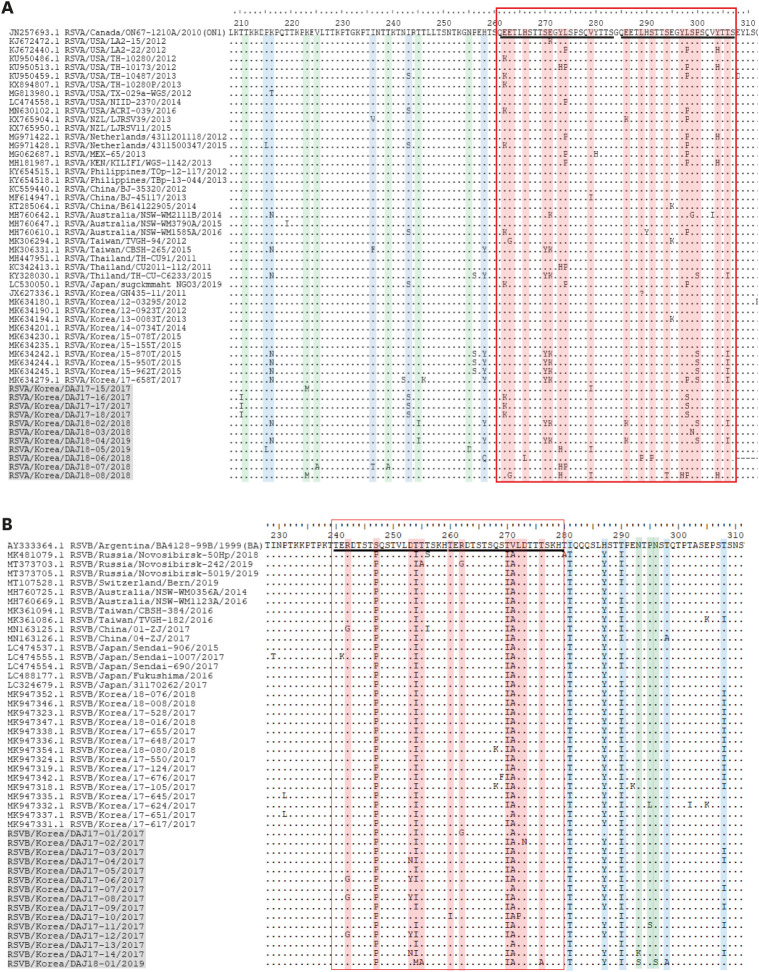J Korean Med Sci.
2020 Dec;35(49):e422. 10.3346/jkms.2020.35.e422.
Circulating Respiratory Syncytial Virus Genotypes and Genetic Variability of the G Gene during 2017 and 2018/2019 Seasonal Epidemics Isolated from Children with Lower Respiratory Tract Infections in Daejeon, Korea
- Affiliations
-
- 1Department of Pediatrics, College of Medicine, The Catholic University of Korea, Seoul, Korea
- 2Clinical Research Institute, Daejeon St. Mary's Hospital, The Catholic University of Korea, Daejeon, Korea
- 3Department of Laboratory Medicine, College of Medicine, The Catholic University of Korea, Seoul, Korea
- 4Department of Pediatrics, College of Medicine, Chungnam National University, Daejeon, Korea
- 5Department of Pediatrics, Daejeon St. Mary's Hospital, The Catholic University of Korea, Daejeon, Korea
- KMID: 2509596
- DOI: http://doi.org/10.3346/jkms.2020.35.e422
Abstract
- Background
Respiratory syncytial virus (RSV) is a major pathogen causing respiratory tract infections in infants and young children. The aim of this study was to confirm the genetic evolution of RSV causing respiratory infections in children at Daejeon in Korea, through G gene analysis of RSV-A and RSV-B strains that were prevalent from 2017 to 2019.
Methods
Pediatric patients admitted for lower respiratory tract infections at The Catholic University of Korea Daejeon St. Mary's Hospital in the 2017 and 2018/2019 RSV seasonal epidemics, who had RSV detected via multiplex polymerase chain reaction (PCR) were included. The nucleic acid containing RSV-RNA isolated from each of the patients' nasal discharge during standard multiplex PCR testing was stored. The G gene was sequenced and phylogenetic analysis was performed using MEGA X program and the genotype was confirmed.
Results
A total of 155 specimens including 49 specimens from 2017 and 106 specimens from 2018-2019 were tested. The genotype was confirmed in 18 specimens (RSV-A:RSV-B = 4:14) from 2017 and 8 specimens (RSV-A:RSV-B = 7:1) from 2018/2019. In the phylogenetic analysis, all RSV-A type showed ON1 genotype and RSV-B showed BA9 genotype.
Conclusion
RSV-B belonging to BA9 in 2017, and RSV-A belonging to ON1 genotype in 2018/2019 was the most prevalent circulating genotypes during the two RSV seasons in Daejeon, Korea.
Figure
Reference
-
1. Korea Centers for Disease Control and Prevention. Pathogens and Vector Surveillance Weekly Report 2020.08.09 to 2020.08.22. Cheongju: Korea Centers for Disease Control and Prevention;2020.2. Hall CB, Weinberg GA, Blumkin AK, Edwards KM, Staat MA, Schultz AF, et al. Respiratory syncytial virus-associated hospitalizations among children less than 24 months of age. Pediatrics. 2013; 132(2):e341–e348. PMID: 23878043.
Article3. Blount RE Jr, Morris JA, Savage RE. Recovery of cytopathogenic agent from chimpanzees with coryza. Proc Soc Exp Biol Med. 1956; 92(3):544–549. PMID: 13359460.4. Crowe JE Jr, Williams JV. Immunology of viral respiratory tract infection in infancy. Paediatr Respir Rev. 2003; 4(2):112–119. PMID: 12758048.
Article5. Kim YJ, Kim DW, Lee WJ, Yun MR, Lee HY, Lee HS, et al. Rapid replacement of human respiratory syncytial virus A with the ON1 genotype having 72 nucleotide duplication in G gene. Infect Genet Evol. 2014; 26:103–112. PMID: 24820343.
Article6. Esposito S, Piralla A, Zampiero A, Bianchini S, Di Pietro G, Scala A, et al. Characteristics and their clinical relevance of respiratory syncytial virus types and genotypes circulating in Northern Italy in five consecutive winter seasons. PLoS One. 2015; 10(6):e0129369. PMID: 26047100.
Article7. Cui G, Zhu R, Qian Y, Deng J, Zhao L, Sun Y, et al. Genetic variation in attachment glycoprotein genes of human respiratory syncytial virus subgroups a and B in children in recent five consecutive years. PLoS One. 2013; 8(9):e75020. PMID: 24069376.
Article8. Parveen S, Sullender WM, Fowler K, Lefkowitz EJ, Kapoor SK, Broor S. Genetic variability in the G protein gene of group A and B respiratory syncytial viruses from India. J Clin Microbiol. 2006; 44(9):3055–3064. PMID: 16954227.
Article9. Baek YH, Choi EH, Song MS, Pascua PN, Kwon HI, Park SJ, et al. Prevalence and genetic characterization of respiratory syncytial virus (RSV) in hospitalized children in Korea. Arch Virol. 2012; 157(6):1039–1050. PMID: 22402914.
Article10. Trento A, Galiano M, Videla C, Carballal G, García-Barreno B, Melero JA, et al. Major changes in the G protein of human respiratory syncytial virus isolates introduced by a duplication of 60 nucleotides. J Gen Virol. 2003; 84(Pt 11):3115–3120. PMID: 14573817.
Article11. Yun KW, Choi EH, Lee HJ. Molecular epidemiology of respiratory syncytial virus for 28 consecutive seasons (1990–2018) and genetic variability of the duplication region in the G gene of genotypes ON1 and BA in South Korea. Arch Virol. 2020; 165(5):1069–1077. PMID: 32144544.
Article12. Peret TC, Hall CB, Hammond GW, Piedra PA, Storch GA, Sullender WM, et al. Circulation patterns of group A and B human respiratory syncytial virus genotypes in 5 communities in North America. J Infect Dis. 2000; 181(6):1891–1896. PMID: 10837167.
Article13. Shobugawa Y, Saito R, Sano Y, Zaraket H, Suzuki Y, Kumaki A, et al. Emerging genotypes of human respiratory syncytial virus subgroup A among patients in Japan. J Clin Microbiol. 2009; 47(8):2475–2482. PMID: 19553576.
Article14. Eshaghi A, Duvvuri VR, Lai R, Nadarajah JT, Li A, Patel SN, et al. Genetic variability of human respiratory syncytial virus A strains circulating in Ontario: a novel genotype with a 72 nucleotide G gene duplication. PLoS One. 2012; 7(3):e32807. PMID: 22470426.
Article15. Zou L, Yi L, Wu J, Song Y, Huang G, Zhang X, et al. Evolution and transmission of respiratory syncytial group A (RSV-A) viruses in Guangdong, China 2008–2015. Front Microbiol. 2016; 7:1263. PMID: 27574518.
Article16. Ramaekers K, Houspie L, Van der Gucht W, Keyaerts E, Rector A, Van Ranst M. A36 Circulating strains of human respiratory syncytial virus in Belgium during six consecutive respiratory seasons (2011–2017). Virus Evol. 2018; 4(Suppl 1):vey010.035.
Article17. Ábrego LE, Delfraro A, Franco D, Castillo J, Castillo M, Moreno B, et al. Genetic variability of human respiratory syncytial virus group B in Panama reveals a novel genotype BA14. J Med Virol. 2017; 89(10):1734–1742. PMID: 28464479.
Article18. Almajhdi FN, Farrag MA, Amer HM. Group B strains of human respiratory syncytial virus in Saudi Arabia: molecular and phylogenetic analysis. Virus Genes. 2014; 48(2):252–259. PMID: 24370974.
Article19. Arnott A, Vong S, Mardy S, Chu S, Naughtin M, Sovann L, et al. A study of the genetic variability of human respiratory syncytial virus (HRSV) in Cambodia reveals the existence of a new HRSV group B genotype. J Clin Microbiol. 2011; 49(10):3504–3513. PMID: 21865418.
Article20. Auksornkitti V, Kamprasert N, Thongkomplew S, Suwannakarn K, Theamboonlers A, Samransamruajkij R, et al. Molecular characterization of human respiratory syncytial virus, 2010–2011: identification of genotype ON1 and a new subgroup B genotype in Thailand. Arch Virol. 2014; 159(3):499–507. PMID: 24068580.
Article21. Blanc A, Delfraro A, Frabasile S, Arbiza J. Genotypes of respiratory syncytial virus group B identified in Uruguay. Arch Virol. 2005; 150(3):603–609. PMID: 15480858.
Article22. Hwang SJ, Park DJ, Gu PT, Koo HS, Lee MO. Characteristics of respiratory syncytial virus isolated from acute respiratory infectious disease in Busan. J Bacteriol Virol. 2016; 46(3):173–180.
Article23. Yon DK, Min CY, Ha EK, Jee HM, Jung YH, Lee KS, et al. Clinical characteristics and genetic variation in respiratory syncytial virus isolated from infants hospitalized due to acute bronchiolitis in Korea during winter season 2016–2017. Allergy Asthma Respir Dis. 2018; 6(2):110–115.
Article24. Kuroiwa Y, Nagai K, Okita L, Yui I, Kase T, Nakayama T, et al. A phylogenetic study of human respiratory syncytial viruses group A and B strains isolated in two cities in Japan from 1980–2002. J Med Virol. 2005; 76(2):241–247. PMID: 15834873.
Article25. Scott PD, Ochola R, Ngama M, Okiro EA, Nokes DJ, Medley GF, et al. Molecular epidemiology of respiratory syncytial virus in Kilifi district, Kenya. J Med Virol. 2004; 74(2):344–354. PMID: 15332285.
Article26. Zlateva KT, Lemey P, Moës E, Vandamme AM, Van Ranst M. Genetic variability and molecular evolution of the human respiratory syncytial virus subgroup B attachment G protein. J Virol. 2005; 79(14):9157–9167. PMID: 15994810.
Article27. Trento A, Viegas M, Galiano M, Videla C, Carballal G, Mistchenko AS, et al. Natural history of human respiratory syncytial virus inferred from phylogenetic analysis of the attachment (G) glycoprotein with a 60-nucleotide duplication. J Virol. 2006; 80(2):975–984. PMID: 16378999.
Article28. Trento A, Casas I, Calderón A, Garcia-Garcia ML, Calvo C, Perez-Breña P, et al. Ten years of global evolution of the human respiratory syncytial virus BA genotype with a 60-nucleotide duplication in the G protein gene. J Virol. 2010; 84(15):7500–7512. PMID: 20504933.
Article29. Dapat IC, Shobugawa Y, Sano Y, Saito R, Sasaki A, Suzuki Y, et al. New genotypes within respiratory syncytial virus group B genotype BA in Niigata, Japan. J Clin Microbiol. 2010; 48(9):3423–3427. PMID: 20610675.
Article
- Full Text Links
- Actions
-
Cited
- CITED
-
- Close
- Share
- Similar articles
-
- Recovery of respiratory syncytial virus, adenovirus, influenza virus , and parainfluenza virus from nasopharyngeal aspirates from children with acute respiratory tract infections
- Lower Respiratory Tract Infection of Respiratory Syncytial Virus
- Characteristics of Respiratory Syncytial Virus isolated from Acute Respiratory Infectious Disease in Busan
- Respiratory Syncytial Virus Infection Complicated by Extrapulmonary Manifestations
- Epidemiology of Childhood Viral Respiratory Tract Infections in Seoul




